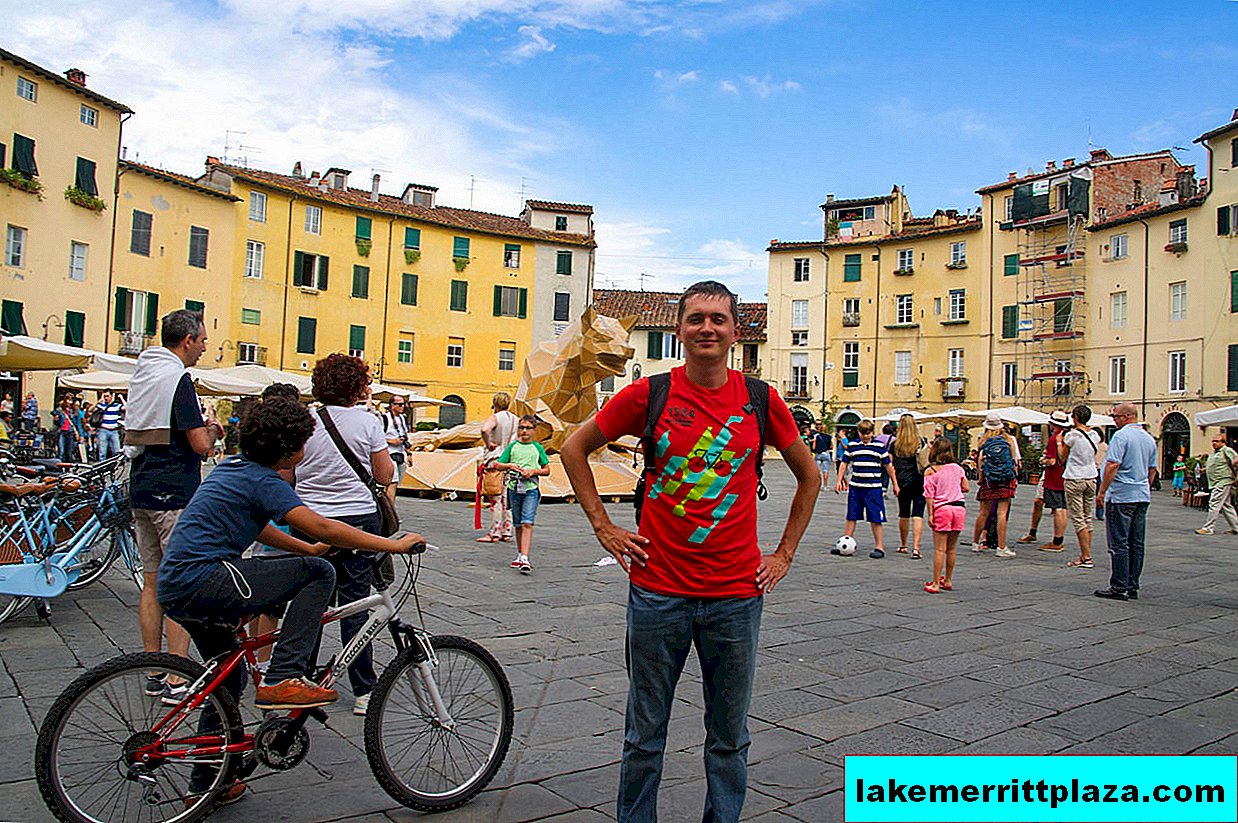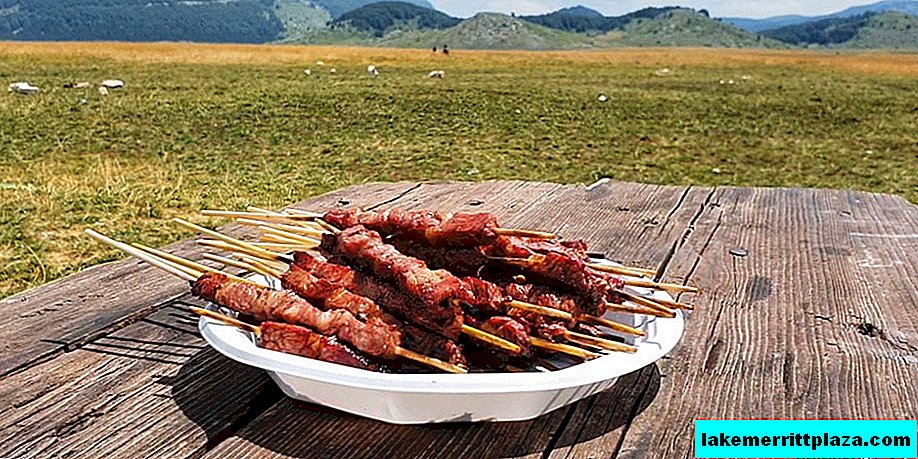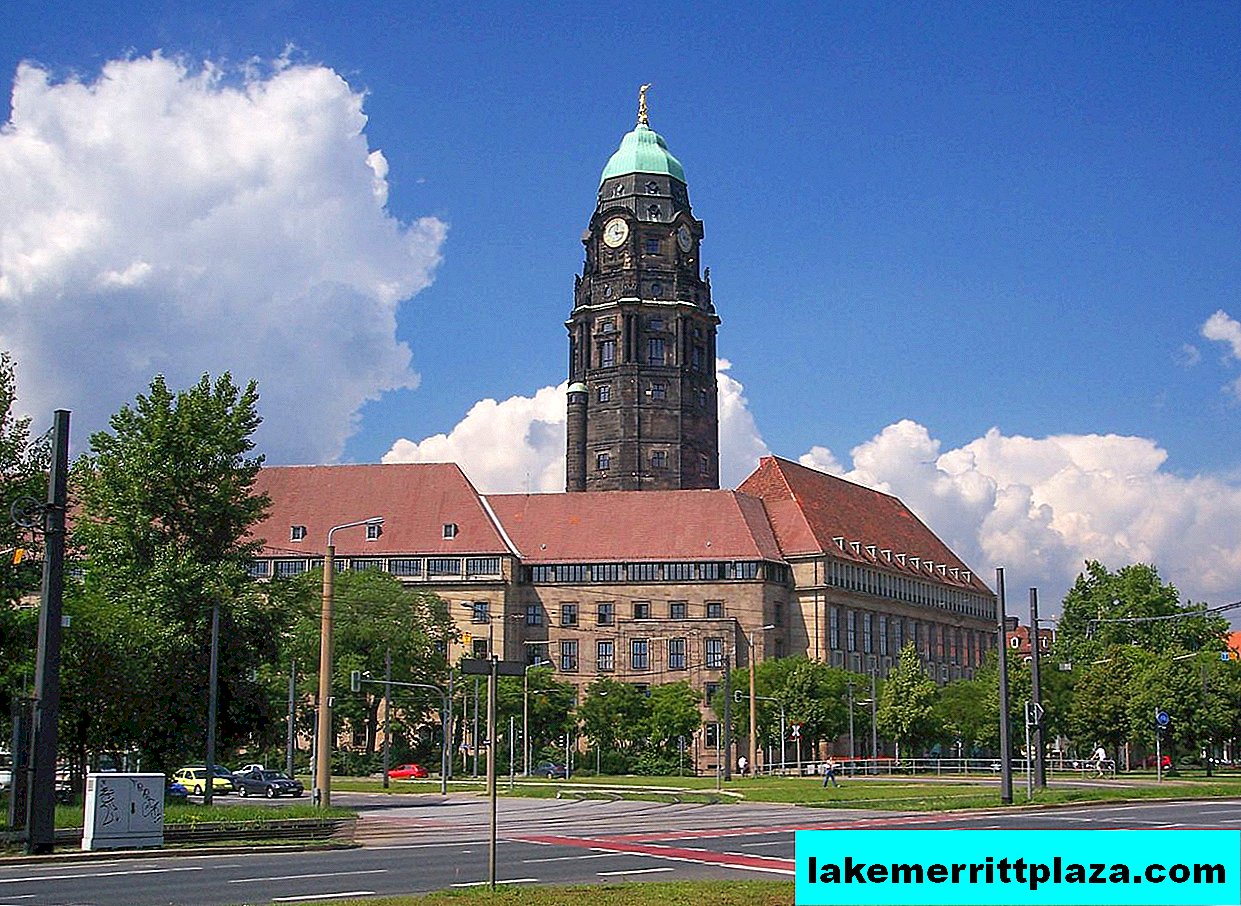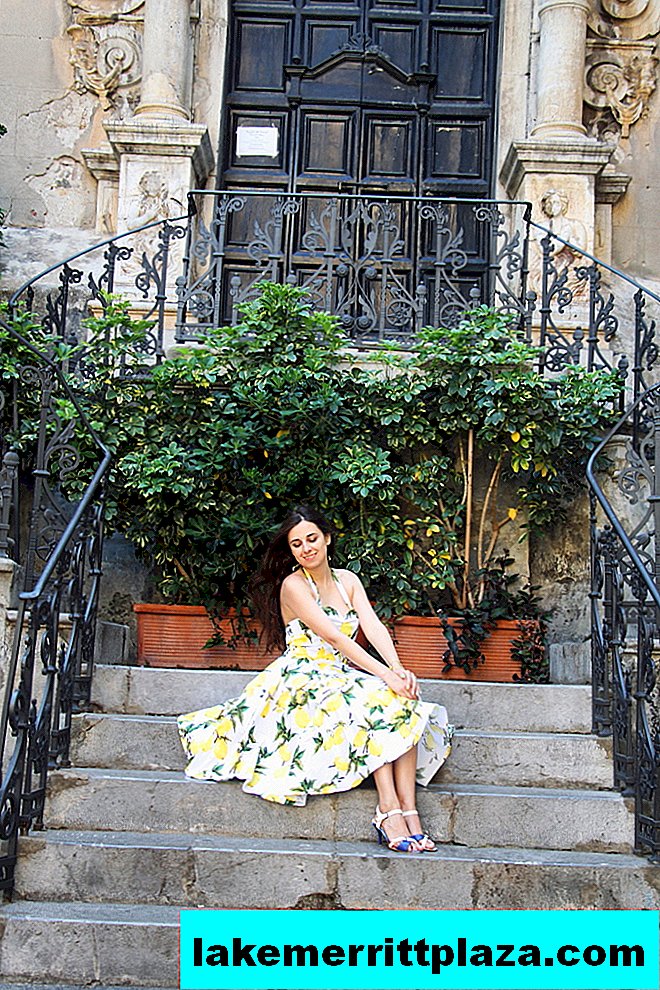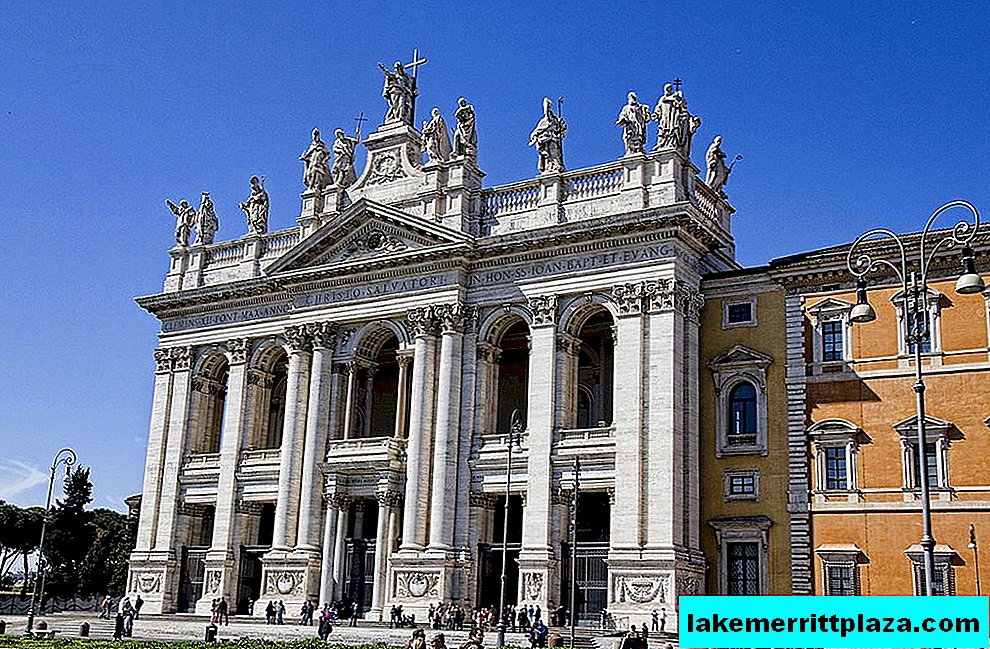In this part of the German sketches, the story will focus on the most interesting pages in the history of Marburg and its two largest sights - Landgrave Castle and the University.

Landgrave Castle in Marburg
German sketches. Part I
German sketches. Part II
German sketches. Part III
German sketches. Part iv
German sketches. Part v
German sketches. Part VI
German sketches. Part VII
German sketches. Part VIII
German sketches. Part IX
German sketches
Part X. Marburg. Castle and University
In the previous part of my report, I talked about Marburg, as a lovely old town, in which there is an amazing fairytale atmosphere, where at every step there are associations with characters and plots of all beloved, familiar fairy tales from childhood. In the same part, I decided to talk about the most interesting pages in the history of the city and its two largest sights - the Landgrave castle and the university.
So, let's start with the story. Russian Wikipedia claims that Marburg was founded in 1228 by the Duchess Sophia of Brabant. Do not believe this news from the category of "British scientists have established ...". This could not be for two reasons. Firstly, in 1228 Sofia Brabant, whose merits before Marburg I mentioned in the previous part of the report, was in her tender infancy and walked under the table. Secondly, Marburg by that time, as a settlement, had existed for at least a hundred years and clearly did not need a re-foundation.
When the city was founded, it is not known exactly. It is only known that at about the turn of the 11th and 12th centuries a small fortification was erected on the Schlossberg hill, designed to protect the border between the Landgrafism of Thuringia and the Mainz Archbishopric. Hence the name - Marburg ("mar (c)" - the border, "burg" - the fortress).
Curiously, it was not the archbishop who defended himself against the landgraph, but quite the opposite. In those good old days, the church fathers did not differ in Christian meekness and humility. The specificity of medieval Germany was that the large church hierarchs - bishops and archbishops - in their possessions possessed not only ecclesiastical, but also secular authority with all its inherent signs. Their own feudal armies sometimes even outnumbered the armies of secular princes, which allowed them to behave very, very aggressively. Here is the Archbishop of Mainz, as A.S. Pushkin, "the neighbors now and then inflicted resentment boldly." Well, the Landgrave of Thuringia, in turn, did everything to give a neighbor his raking hands.
Gradually, the hill around the fortification began to be built up and a settlement arose, the first mention of which in written sources refers to 1138. In 1140, a coin was launched in Marburg - the Marburg Pfennig. True, this does not mean that the city by that time had acquired great strength and wealth - in medieval Germany, everyone who felt like it was minting a coin - large feudal lords, prelates, clergy, and free cities. In 1222, Marburg received city rights.
The impetus for the further development of the city was the fact that in 1264 it became the residence of the rulers of the new principality of Hesse. It was precisely for this that the Duchess Sophia of Brabant had a hand, who ruled Hesse for the first 11 years from the day it was founded. With her, a small fortification on top of Schlossberg began to rebuild into a large and beautiful castle. And although two years after the death of the Duchess, in 1277 her son - the first landgrave of Hesse, Henry I - moved his residence to Kassel, the Landgrave castle in Marburg continued to be expanded and rebuilt. He acquired his final appearance at the beginning of the 16th century.
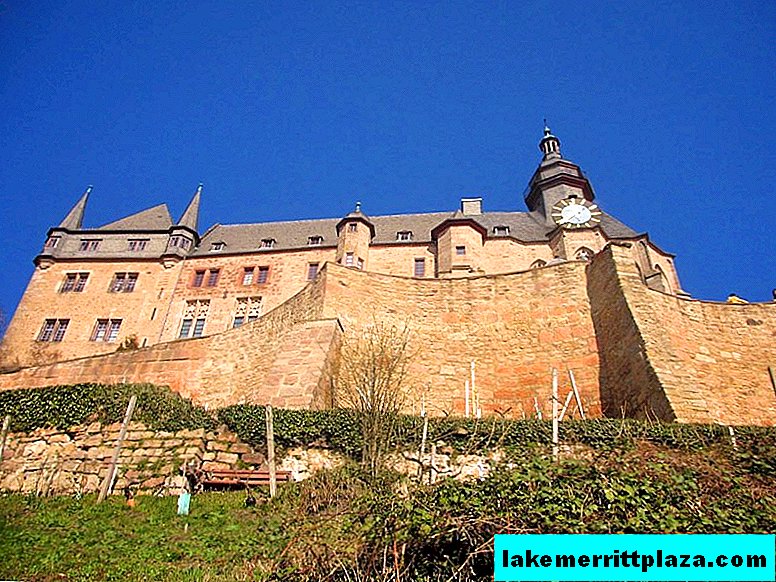
Hesse Landgraves Castle in Marburg
True, unlike our time, then it also had powerful defensive fortifications, which, along with the city fortress wall, were gradually torn down during the 18th-19th centuries. We went to admire the castle immediately upon arrival in Marburg.
Schlossberg hill ("schloss" - castle, "berg" - mountain), on top of which stands the castle, dominates the city. Its height is 287 meters, so getting to the castle is not so easy. You can climb the numerous steps of one of the narrow streets, stairs, running from the top of the hill to its foot, but we chose a different path - along a cobbled road, the same one along which, in the Middle Ages, pedestrians wandered up and rode horses.
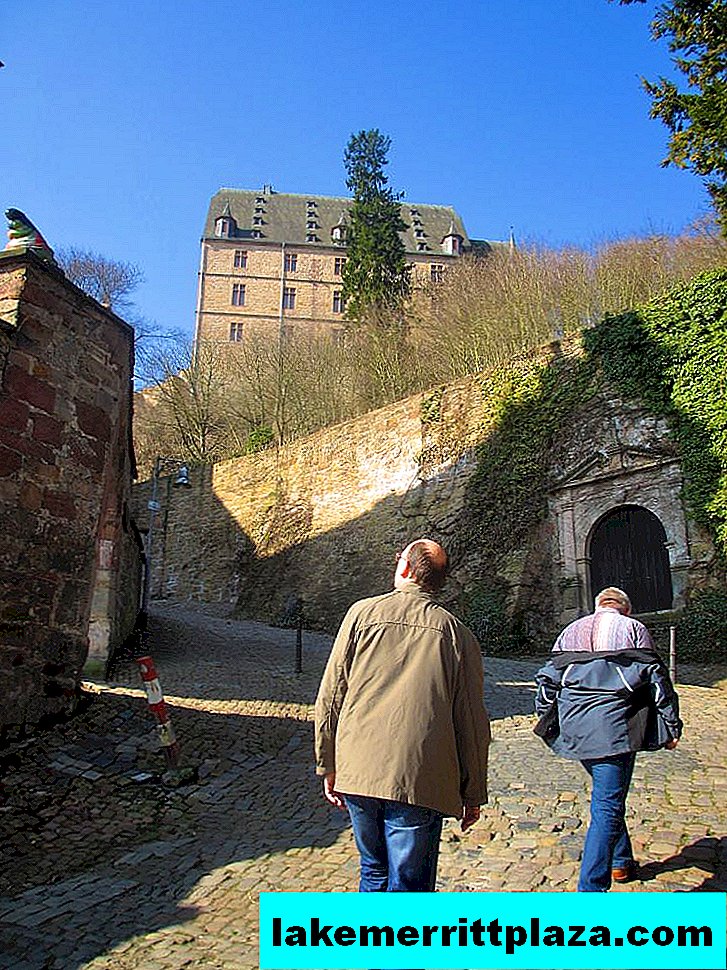
On the way to the castle
In one place on the wall that encloses the road, are the heads of the dwarves in caps.
We can assume that in Marburg there is a version of the tale of Snow White and the Seven Dwarfs. And perhaps this option does not imply a happy end. And it suggests, for example, the following.
Fairy gnomes got treasures in the deep dungeons so that Snow White could get married with a rich dowry. They probably wanted the poor orphan to have everything as people do - a handsome and intelligent husband from a decent royal family, a multi-room palace in the center of the capital city, an import executive carriage, where it is not shameful to go to barbecue in a country castle. But one day, on one terrible day, a bad idea came to their minds - to avoid paying taxes on the use of natural resources. The evil queen, from whom they rented underground bowels, did not squeeze their business, send them numerous inspections - sanitary and epidemiological surveillance, firefighters, tax inspectorate, and resolved the issue radically - with the help of the executioner. For others to be discouraged. What happened to Snow White at the same time is a mystery covered in darkness. From the very evil queen to our times, one shoe has been preserved. But what a thing! Apparently, the large was a woman.

Sample fabulous shoes
And finally, we are at the gates of the castle.
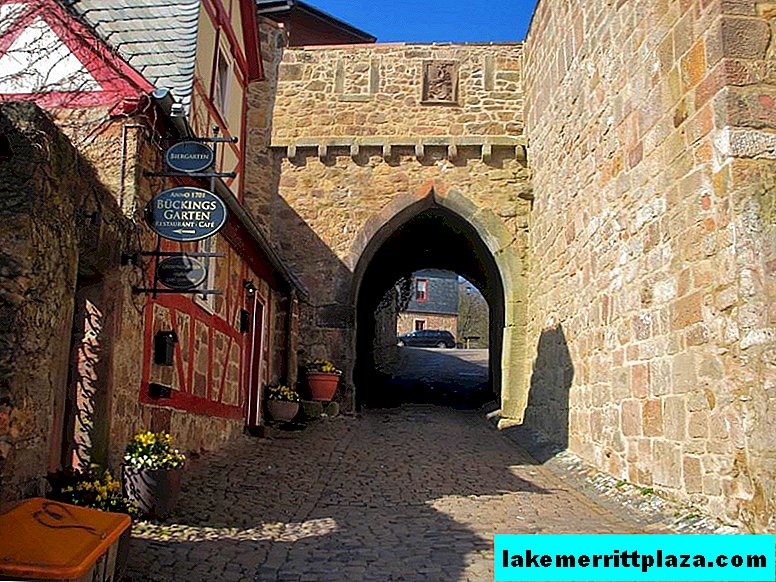
Gate of the Marburg Castle
Visitors are greeted with flowers.

Flowers at the gates of the castle
In the span of the gate there is a drinking fountain in a medieval style.
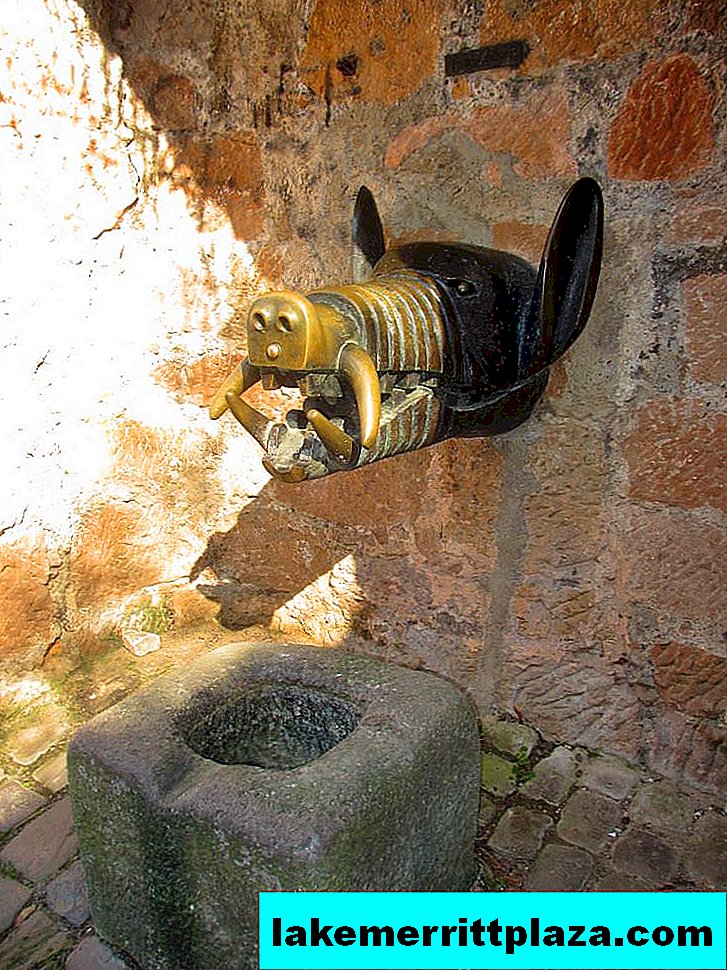
Drinking fountain
In the summer, in the heat, after climbing the castle hill, this source of life-giving moisture is very handy. But in mid-March, he had not yet worked.
By the way, for those who are exhausted, rising to the castle, there is another nice bonus. To the left of the castle gate is the entrance to the cafe-restaurant. In the photo with the image of the gate, its sign is visible.

Open area of the castle restaurant
Sitting at a table in the open area of the restaurant, you can not only have a bite to eat, but also admire the panorama of the city below. But man does not live by bread alone. There is another kind of hunger and thirst - a passion for adventure, new experiences and learning not yet known. Therefore, we, ignoring the restaurant, rushed through the gate forward - to spiritual food. And here is the castle in all its glory.

Landgrave Castle in Marburg
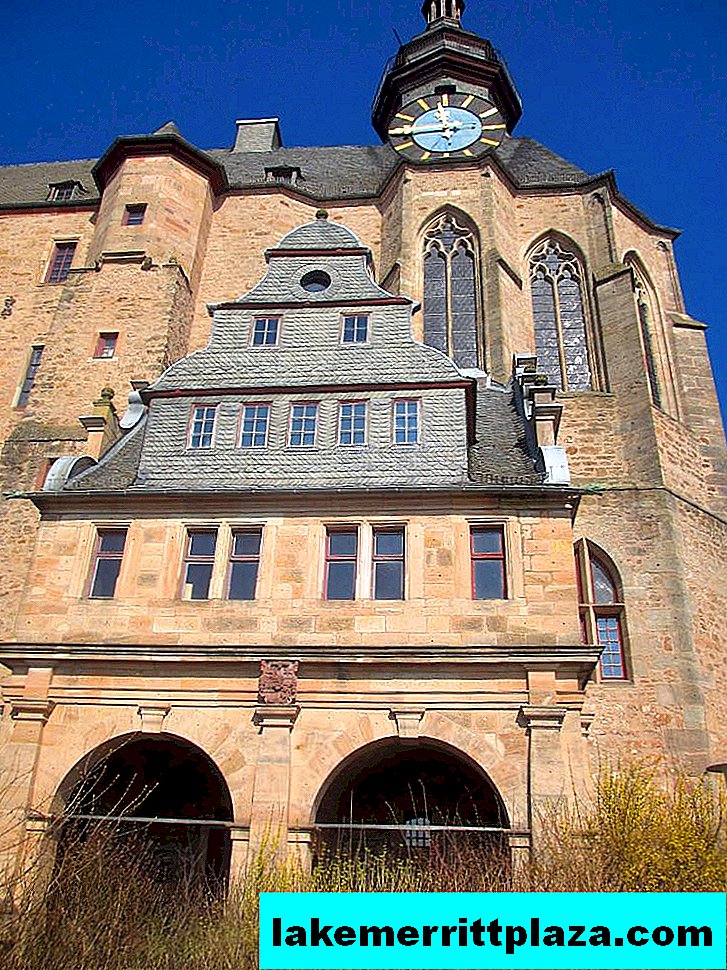
Landgrave Castle in Marburg
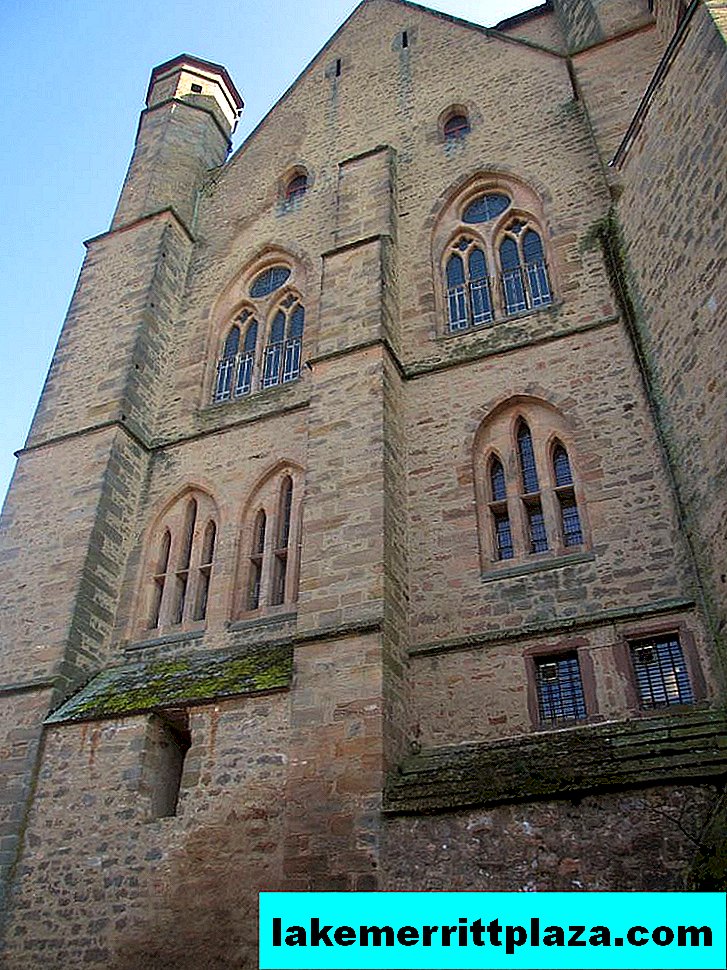
Landgrave Castle in Marburg
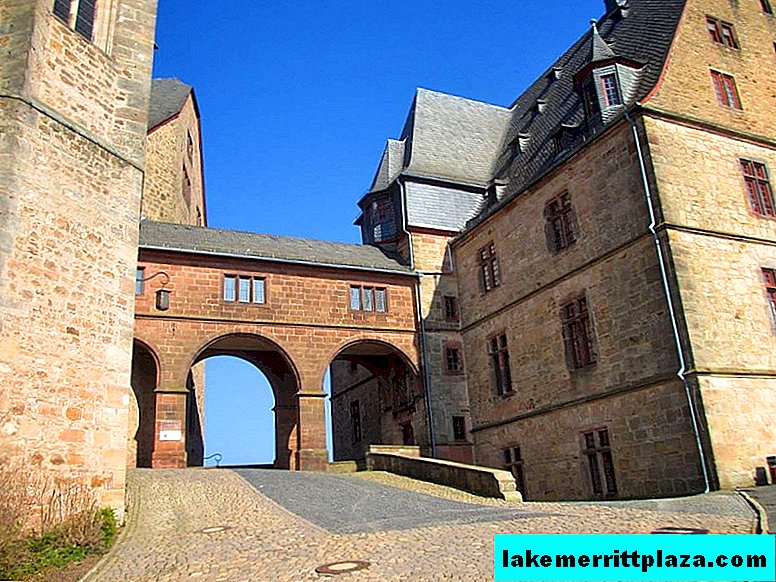
Landgrave Castle in Marburg
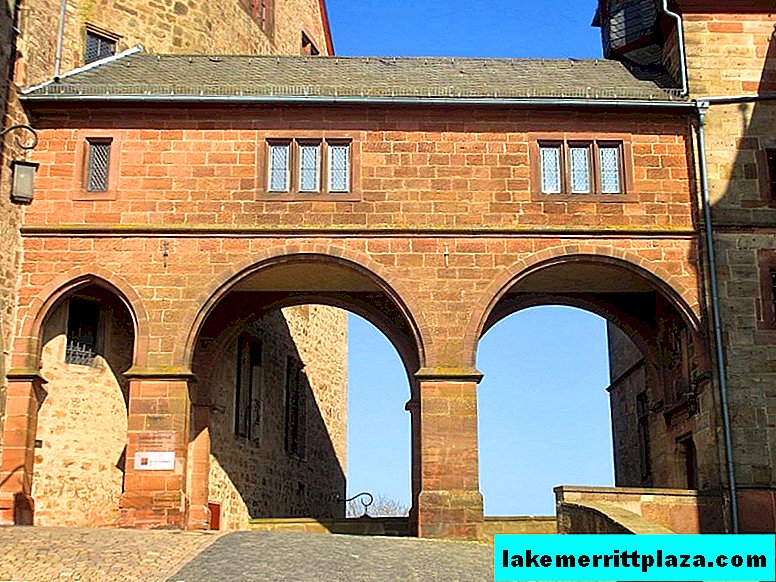
Landgrave Castle in Marburg
In the courtyard of the castle is a bas-relief depicting St. Elizabeth and her husband - the landgrave of Thuringia Ludwig IV the Saint. I already talked about this bas-relief in the previous part of the report, so I will not repeat it. In the next photo, he is at the foot of the tower on the right, between two doors.

Castle courtyard
The windows of the tower really resemble a parallelogram in shape, this is not a distortion of vision when viewed from a certain angle.

Tower in the courtyard of the castle
Above the entrance to the courtyard from the inside there are local tablets of history.

Castle courtyard
Now in the main building of the castle on five floors there is a museum of history and culture of the local university. The most famous of its premises is the Princely Hall, built in 1330, the largest Gothic hall in Germany.
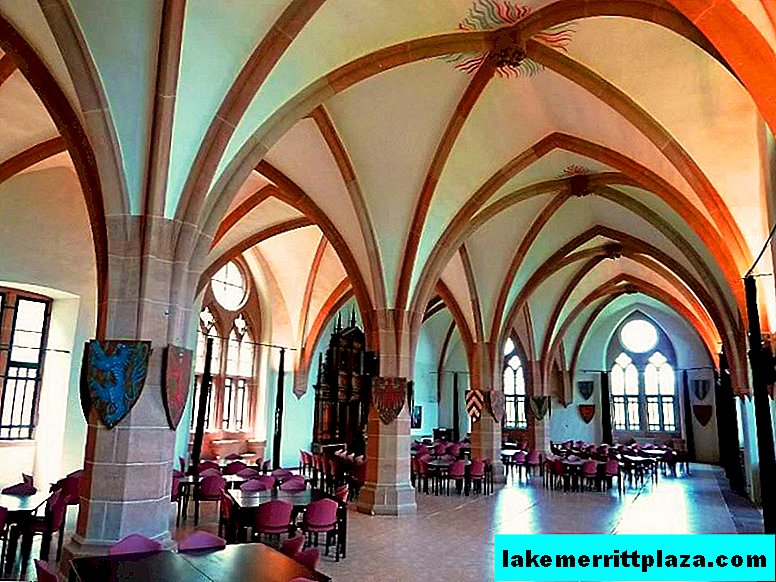
Gothic Princes Hall in Marburg Castle
In 1529, the Marburg Talk of Religion took place in it - a debate about the importance of communion between the ideologists of the two directions of the Reformation - Martin Luther and Ulrich Zwingli.
Here, along with many knightly shields with coats of arms, is one of the most valuable exhibits of the museum - an old tapestry depicting scenes from the biblical story of the prodigal son.

Medieval tapestry
For the right to own this tapestry, the Catholic and Protestant communities of Marburg argued. The French who occupied Hesse during the Napoleonic Wars made a Solomon decision. They cut the tapestry in half and gave half to the Catholics, and the other to the Protestants.
The castle chapel looks very nice.

Castle chapel
Personally, I liked the museum’s armory the most, where there is an extensive exposition of cold and firearms, armor, ammunition and military uniforms from different eras - from the Middle Ages to the 19th century.
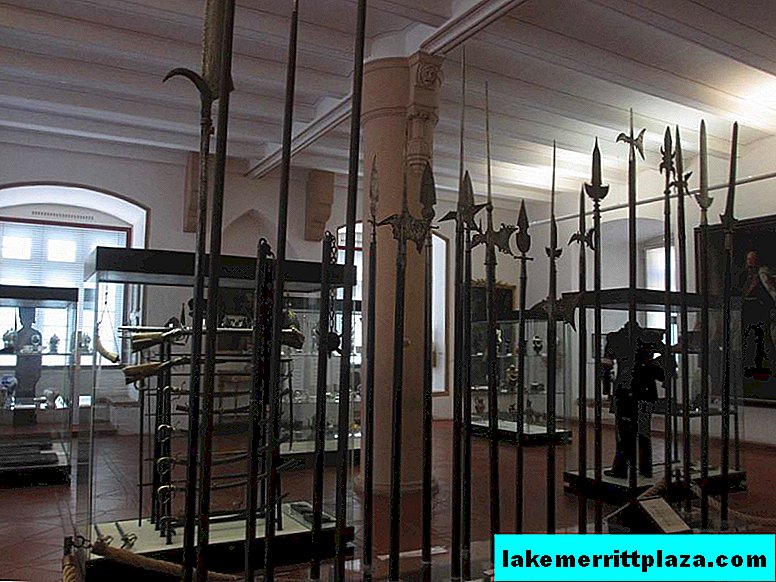
The Armory Hall of the Museum in Marburg Castle

The Armory Hall of the Museum in Marburg Castle

Museum exhibits
The castle has a small park where you can rest after exploring the museum halls.
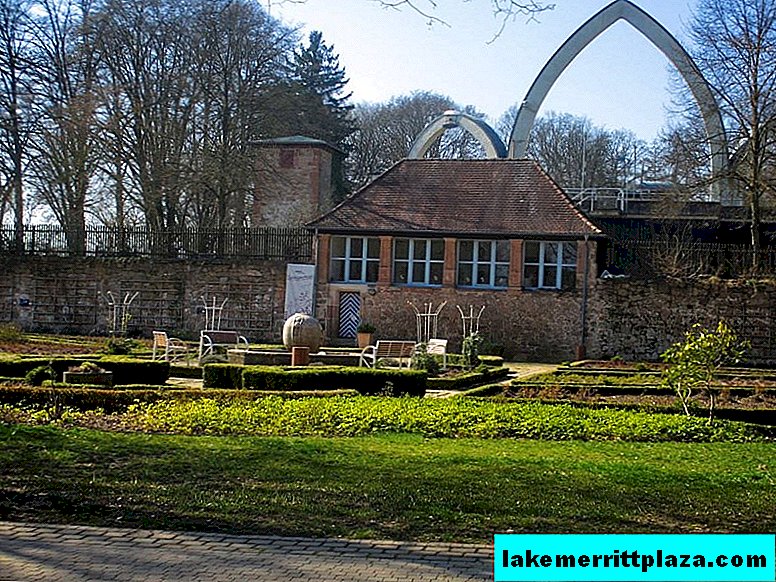
Marburg Castle Park
Near the castle stands the Witch's Tower.
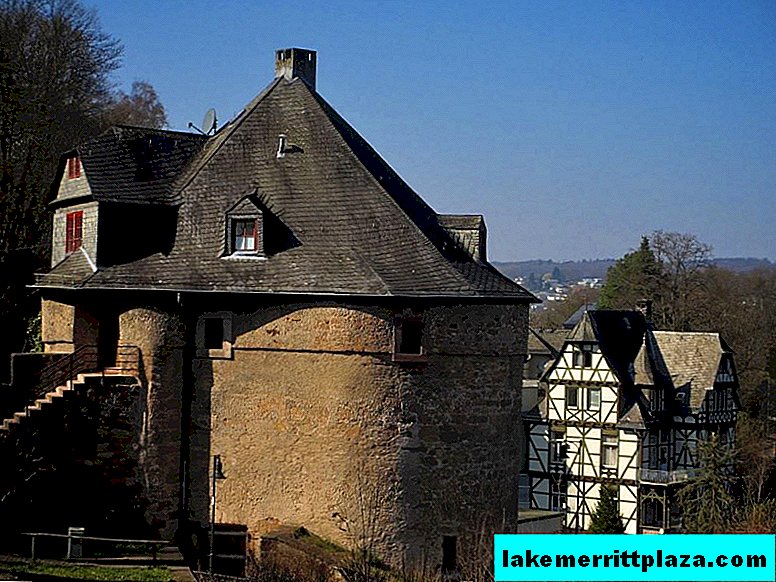
Witches Tower at Marburg Castle
It is known that the Catholic inquisitors, who sent thousands of heretics to the bonfire, were quite loyal to the representatives of the occult. All sorts of magic, of course, was not encouraged by the church, but the activity of its followers, until Pope Innocent VIII in 1484 issued a bull against witchcraft, was often looked through with fingers. However, with the beginning of the Reformation in Western Europe, the season of the great witch hunt was opened. During the sixteenth and seventeenth centuries, more people were executed on charges of witchcraft than a good thousand years before. At the same time, secular authorities were sometimes more ferocious than the church ones, and Protestants were much more intolerant of witches and sorcerers than Catholics. Here in Hesse, which, as you know, was a Protestant principality, witches were captured and destroyed with great enthusiasm, and in Marburg they even allocated a separate tower in the Landgrave castle for their preliminary detention.
After visiting the castle, we began to descend from the mountain not along the road, but along the stairs leading to the Church of the Blessed Virgin Mary. Yes, the one with the slanting spire on the tower, which I talked about in the previous part of the report. During the descent we saw just such a sculpture, which, obviously, displays a certain averaged image of the Hessian landgraves of the Middle Ages.
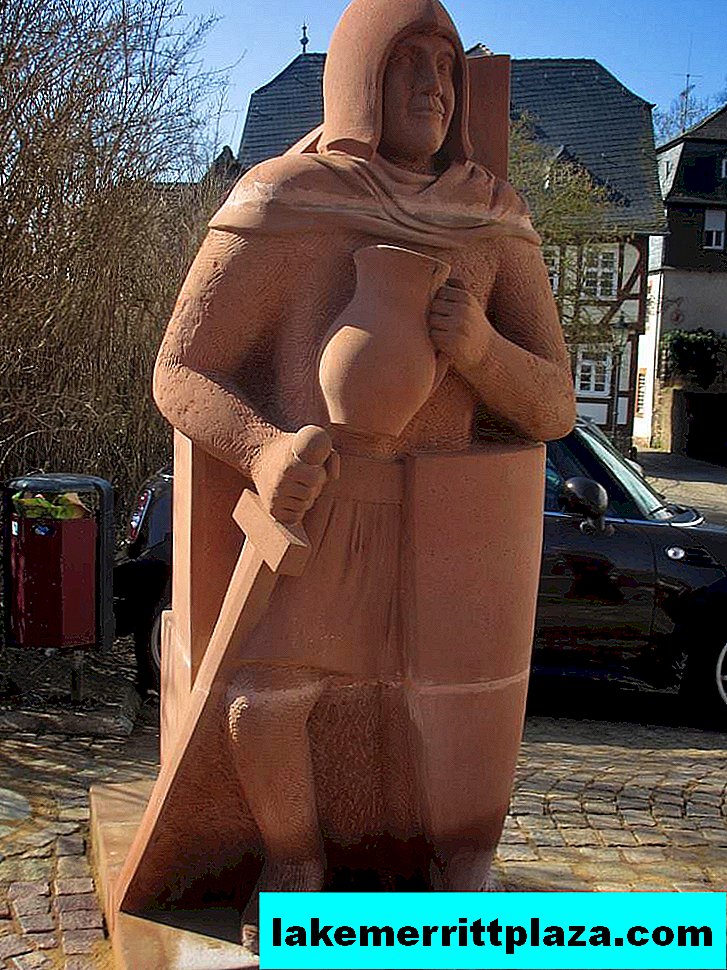
"Yes, there were people in our time, not that the current tribe ..."
Judging by the objects that the statue holds in their hands, the Hessian landgraves were not averse to wave their sword, and after that they would drink and have fun from the heart. Of course, not out of love for drunkenness, but only in order to relieve tension and relax.
When I got acquainted with the history of Thuringia and Hesse, I was very curious to find out who the landgraves were, and how they differed from ordinary counts. Having thoroughly rummaged on the Internet, I found out the following.
The feudal ladder of medieval Germany, in contrast to the classical version, which provided for the subordination of feudal lords from the bottom up along the chain of “knights - barons - counts - dukes - king", had its own specifics. According to her, the numerous counts were really subordinate to not so many dukes. But margraves, palatine graphs and landgraves were moved beyond the feudal ladder, as they directly obeyed the king, who, as a rule, was also the emperor of the Holy Roman Empire of the German nation. Compared to simple counts, they had expanded rights and powers, since they controlled territories that were of particular importance to the empire.
Margraves ruled the "stamps" - the border regions of the empire. The inhabitants of the "brands", which for centuries existed under the conditions of incessant border clashes and wars, forged a strong and persistent character. Confirmation of this is that the territory of the Brandenburg brand became the basis of the Prussian kingdom over time, uniting the disparate Germanic principalities in a single state in the 19th century, and the territory of the Eastern mark became the springboard for the creation of a multinational Austro-Hungarian empire.
The Palatinate rulers ruled the territories on which the temporary royal residences - the Palatinate - were located. The fact is that in medieval Germany there was no permanent capital city and a permanent ruling dynasty. The elected emperor king, traveling about his vast monarchy over the vast territory of the empire, had the opportunity here and there to lay his head in one of the palatinate.
According to the imperial Golden Bull of 1356, among the seven German electors (permanent prince-electors of the king) were the Margrave of Brandenburg and the Palatinate of the Rhine.
Landgraves and the princedoms ruled by them, as well as the barons, by the way, were directly subordinate to the king under imperial laws. This was done in order to at least to a small extent balance the power of the king and the power of the dukes, whose wealth and power were often many times greater than the royal.
From the foregoing, it follows that in medieval Germany the Margraves, Palatine and Landgraves were large imperial princes, controlled extensive hereditary estates and in their status stood much closer to the dukes than to simple counts.
One of the most famous landgraves of Hesse was Philip the Magnanimous, who, among other glorious deeds, founded the first Protestant university in Europe in Marburg in 1527.

University of Marburg
Since Landgrave Philip was an extremely zealous supporter of the Reformation, he expelled all Catholic priests and monks from his possessions. At the same time, he transferred the complex of buildings of the former Dominican monastery that was vacated in Marburg to the newly established university. Now Marburg University bears his name.

University of Marburg
A local saying goes: "There are universities in other cities, and Marburg itself is a university." In the year that the university began its activities, 11 professors taught and 84 students studied there. Now among the 80,000th population of Marburg, students, teachers and other university employees make up more than one quarter. Among students, about a tenth of them are foreigners from almost a hundred countries of the world. In a relatively small town, 300 buildings are owned by the university. The most beautiful of them, of course, are those that were rebuilt from the old monastery complex in the 19th century in the Neo-Gothic style.

University of Marburg
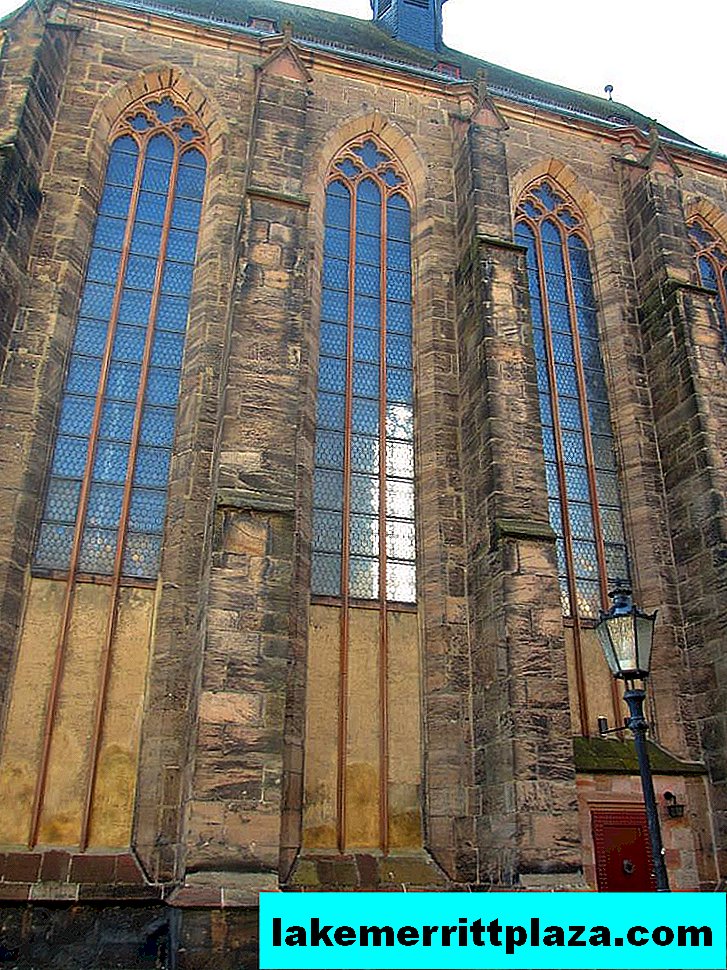
University of Marburg
Among the people who have ever studied at the renowned university, there are seven Nobel laureates, including the Russian poet and writer Boris Pasternak (he, however, studied only one semester at the Faculty of Philosophy). The names of the three Nobel laureates are also on the list of university teachers. At the end of the 16th century, for some time, lectures were given at his departments by the notorious rebel and freethinker Giordano Bruno, who was burned later, in 1600, at the stake of the Inquisition as an inveterate heretic.
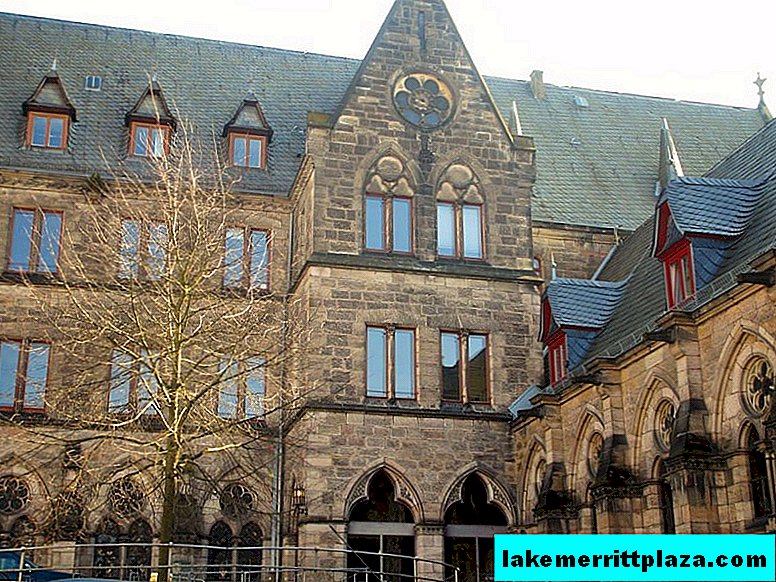
University of Marburg

University of Marburg
Speaking about the history of the University of Marburg, one cannot help but recall that in 1736-1739 the founder of Moscow University, Mikhail Vasilievich Lomonosov, studied there. This is reminiscent of a memorial plaque installed on one of the university walls.
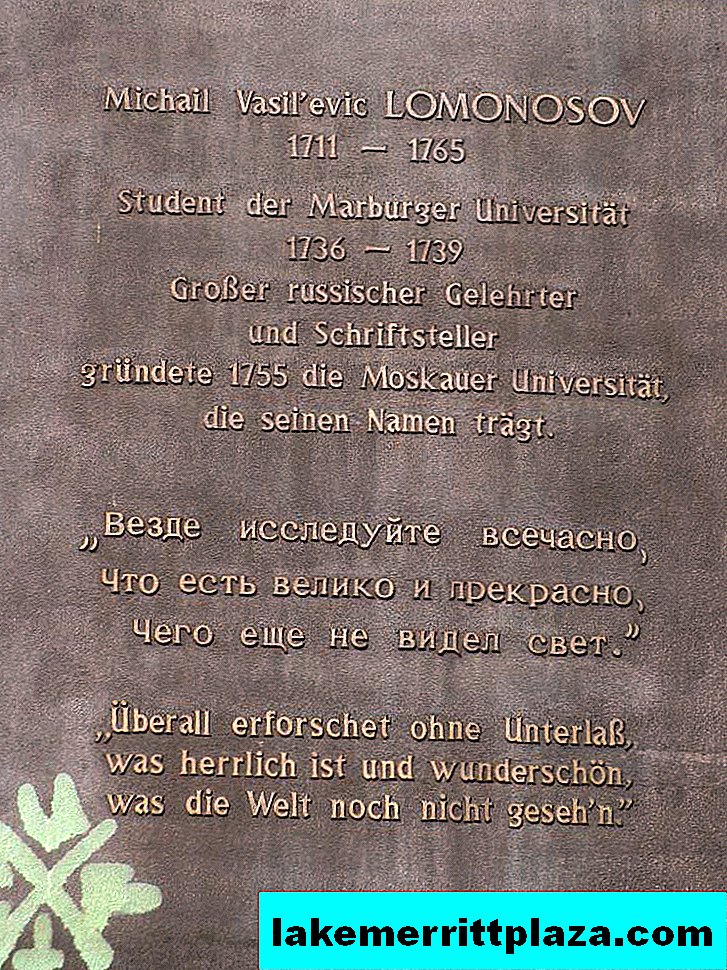
Commemorative plaque in honor of M.V. Lomonosov
Together with Lomonosov, another future scientist studied in Marburg - the creator of Russian porcelain, chemist Dmitry Vinogradov.
The life of these two future lights of young Russian science in Germany was so turbulent that the events of which it consisted could serve as a good basis for a thick adventure novel. However, by their behavior they did not stand out at all from the general mass of the then student body. Since the Middle Ages, the studiosuses of Western Europe have been distinguished by violent disposition and a tendency to commit various kinds of reprehensible acts - drunken fights, fights, duels, etc. etc. Law-abiding philistines treated them with obvious apprehension, considered them to be ungodly, blasphemers and extravagant. However, all of the above did not prevent many students, in parallel with unimportant acts, from stubbornly gnawing at the granite of science, gaining the necessary knowledge and subsequently becoming successful lawyers, church leaders, doctors, scientists and officials. Literate people in those days were snapped up and, as a rule, settled down pretty well in life.
On the territory of Marburg University there is a place where everyone can feel themselves in the shoes of a student of one of the ancient universities.

You used to sit at your desk and legs chatting ...
While exploring the university territory, we found several information boards made in the form of an open book, on one of the pages of which the information is presented in the usual alphabetic font, and on the other - using alphabet symbols for the blind.
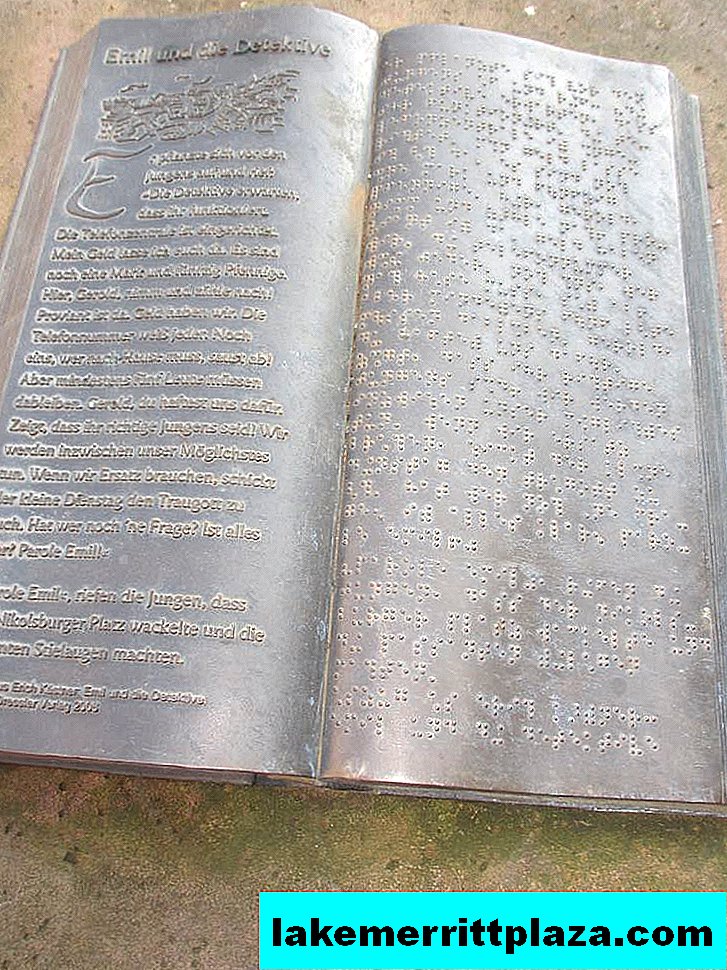
Universal Information Board
In Marburg there is a unique German Institute for the Blind, which is developing methods that allow blind people to relatively freely navigate in an urban environment without outside help. There is a workshop at the institute, which is engaged in the production of reduced mock-up copies of the most interesting excursion objects located in different cities of Germany. Included with the mockups are information boards, similar to those that I described above. Blind tourists can touch with the help of a layout to get an idea about a particular object and read information about it.
In Germany, in general, a lot is being done in order to make life easier for people with disabilities. In Marburg, in particular, the university for the first time in Germany equipped one of the hostels specifically for students with disabilities.
And in general, Germany, even with a brief acquaintance with it, immediately gives the impression of a country where it is very comfortable for any person to live. Reasonable laws, the iron order and the convenience of using everything, whatever it is, the highest level of social protection of the population, literally everything that you encounter in the country, makes you involuntarily exclaim: "Das is fantastic!"
Everything ever ends, including travel. The day after the trip to Marburg, we had to fly home to Russia. And this means that it is time to round off and summarize everything that was said earlier. Concluding the report, in the afterword I want to state all my general thoughts and conclusions on the topic of travel to Germany. And even take the liberty of giving some advice to potential tourists.
Afterword
There is quite a lively passenger flow between Russia and Germany. There are flights to different cities of Germany not only from two capital cities, but also from some regional centers. A lot of people travel, and some of our citizens visit Germany several times during the year. With all this, the total mass of tourists is negligible. Basically, people go on business trips (Germany is our main economic partner in Europe), visit relatives and friends (the Russian-speaking diaspora in Germany is very numerous), to work, to study, as part of any cultural programs, for treatment at the famous balneological resorts, cheer for our athletes at international competitions, for the purpose of shopping or just to unwind. Of course, all of them, having arrived in Germany, do not sit idle out in negotiations at offices, in houses or apartments with relatives and friends, and do not kill themselves without days off at work or in classrooms. In their free time they get to know the country of residence. They, too, to some extent can be called tourists. But ... After all, we don’t think we are tourists who, without crossing the borders of the country, go to another region on a business trip or visit, or cheer on their favorite team playing away, or heal in a resort with a social insurance package. In Russia, it wouldn’t even occur to anyone to consider students who study not in their hometown, but in some other city, or outback residents who go to the regional center for shopping as tourists. It follows from all this that there are not so many tourists, that is, those people who have chosen a trip to Germany from many other options and for whom acquaintance with the country, its history and culture is the main purpose of the trip. Three main factors determine this not very specific statistic.
First, German authorities are extremely reluctant to issue tourist visas to Russians. Secondly, the consequence of the cool attitude of the German Ministry of Foreign Affairs towards Russian tourists is that our travel agencies have very few programs in Germany and the prices for these programs are extremely high. Thirdly, for Germany no one has yet come up with such a killer advertising slogan as "See Paris and die," so tourists who prefer European sightseeing tours, in nine out of ten cases, opt for France or Italy. Meanwhile, in Germany there are also many places, having seen which, you need to try very hard so as not to die of pleasure, by analogy with Paris.
By writing my report, I made an attempt to make up for the lack of advertising in Germany as a tourist destination, and at the same time refute the stereotypes about the high cost and inaccessibility of Germany for middle-income tourists (not from the realm of fantasy, the statistical level, but the real income level). At the same time, I deliberately bracket out the fact that over the past year the euro has risen in price by one and a half times. God willing - everything will be formed. Life, it's like a zebra - striped. Now I can say with full confidence - you can go to Germany quite on a budget. But on condition that you refuse the services of travel agencies and organize the trip yourself. Having acquired some, albeit very modest, experience of independent travel, I want to share it with everyone who considers it necessary to use it.
As I wrote in the first part of the report, air tickets from Moscow to Germany and vice versa can be bought through the Internet very cheaply. If you take care of this three to four months before the trip. The most low-cost flights are to Berlin, Dusseldorf, and Munich. In early December 2013, my wife and I bought tickets for March 2014 on the Moscow-Dusseldorf-Moscow route for 263 euros for two (at the then exchange rate of 12,000 rubles). In November, these tickets were even cheaper. You can, of course, buy tickets with a departure from your hometown (we live in Perm), but they will cost, at best, two and a half - three times more expensive. Therefore, the most budget option is by train to Moscow, then by plane to Germany.
Our friends with whom we visited completely relieved us of worries about accommodation, food and transport. However, before we accepted their kind invitation, I had already fully developed a program for an independent trip to Bavaria, which, due to our changed plans, was postponed for the future. Therefore, I know that in a city as expensive as Munich, even by German standards, you can book a hotel near the historical center and the railway station at an affordable price (between 60-70 euros for two per day, with breakfast). There are quite enough hotel reservation systems on the Internet, and if there is no suitable option in one of them, then it will certainly be found in the other. Remember that hotels often hold discounts. For me, linking the hotel to the railway station is very important, because it makes it easier to go on excursions outside the base city, that is, the city where you fly, where you live most of the duration of the trip and where you fly back home from. Selecting one city as the base city allows you to minimize transportation costs: firstly, air tickets are much cheaper if you fly back from the same city where you fly, and secondly, you do not need to spend money on long trips across the country.
It is extremely important to avoid lengthy train crossings when planning a budget trip to Germany, since the tariffs at Deutschean, a group of German railways, are very high. However, there is one very effective way to radically reduce the cost of railway transport. Just as birds go in flocks when flying south, so you, my friends, I advise you to go in groups of 5 people when traveling to Germany. This allows the use of so-called group land tickets, which are valid either for groups of up to 5 adult passengers, or for two parents or grandparents with an unlimited number of native children or grandchildren aged 6 to 14 years. For example, in Bavaria this is a “Bavarian ticket”, which is valid throughout Bavaria + makes it possible to go to the Austrian Salzburg; and the “Bavarian-Bohemian ticket”, whose coverage, in addition to Bavaria, extends to the western border regions of the Czech Republic, including the cities of Karlovy Vary, Pilsen and Ceske Budejovice. These tickets are valid for traveling in class 2 cars on local trains, as well as on all types of public transport - city and commuter trains, buses, trams, and metro. The validity of Bavarian and Bavarian-Bohemian tickets is on weekdays from 09-00 to 03-00 the next day, and on weekends - from 00-00 to 03-00 the next day. The cost of a Bavarian ticket for a single passenger is 26 euros, for a group - the cost of a single ticket + 4.5 euros for each additional passenger. Thus, each individual passenger traveling as part of a group of 5 people, the ticket will cost less than 9 euros. Agree, this is a meager fee for the opportunity to travel for 18 hours on weekdays and 27 hours on weekends over a vast territory by any means of public transport, except high-speed trains and taxis. There are similar tickets in every federal state of Germany, however, each land may have its own specifics, including not very pleasant ones. So, for example, in the federal state of North Rhine-Westphalia, where we lived, the prices of group land tickets are not at all encouraging.
Talk about nutrition. For gourmets who cannot deny themselves obligatory visits to cafes and restaurants, a budget trip will not work. Germany is not the Czech Republic or Poland, where you can overeat for relatively little money. The only consolation is that in France and Italy, where more romantically inclined citizens so aspire, food is even more expensive. However, if you are not particularly pretentious and ready to serve yourself, without resorting to the services of waiters, then, I dare to assure you, you will find many places in German cities where you can eat tasty and inexpensively.
Firstly, right on the streets in many places they sell appetizing hot sausages, with and without garnish.
Secondly, in Germany there are many Turks who have accustomed the indigenous people to their fast food - Doner. Doner - this is such a Turkish shawarma, an enhanced portion of which may well replace a full meal. After all, this is a cake, and meat, and vegetables, sprinkled with spicy sauce. Hearty and tasty. You’ll just lick your fingers!
Thirdly, you can eat absolutely inexpensively at the food court of any major shopping center.
Fourth, one of the brands in Germany is the fast food chain "NORDSEE" (Nordsee) - inexpensive fish self-service restaurants where everyone can make a choice in accordance with their taste and thickness of the wallet. In "NORDSEE" there are daily promotions for which individual dishes can be bought at a very low price.
Fifth, all kinds of McDonalds, Starbucks and King Burger in Germany are also a dime a dozen. In general, even with a low budget, trips to Germany you can live and be completely happy with your life. And, in the end, in order to fully penetrate the spirit of Germany, a couple of times you can, having returned tired after the next excursion, visit some cozy restaurant. Indeed, the desire for reasonable economy does not mean a complete rejection of the small joys of life and immersion in the abyss of dull asceticism. If, God forbid, suddenly any force majeure circumstances occur, as a result of which your personal finances will be on the verge of default, do not forget that in German shops there are more than enough bread, cheese and sausages for home-made sandwiches.
You can independently develop an excursion program in the same way as you can book air tickets and hotels - using the Internet. True, unlike booking, this is a rather painstaking task, requiring perseverance and a lot of time. Not everyone likes it. But if you overpower yourself and try hard, you will get an undeniable advantage over organized tourists - absolute freedom of action. Well, and save, of course. And it’s very, very decent. If you are not ready to refuse the information that guides usually tell, buy a guide - it says almost the same thing. Even the thickest and most detailed, and therefore the most expensive, guide will cost you much cheaper than organized guided tours. They also allow you to save money on tours with discount museum cards, which can be purchased in almost every major European city. I have my own system for developing independent excursion programs. I talked about it in sufficient detail in the second part of my other report, “My Czech Travels,” so I will not repeat it here.
Summing up some intermediate result regarding recommendations on the preparation for the trip to Germany, we can say the following. If we take as a basis the duration of the trip of seven days, or rather, 8 days / 7 nights (the optimal average duration of European city tours sold by most tour operators), and the minimum cost of daily expenses per person in the amount of 50-60 euros (conditionally, one half - for food, the other - for transport and excursions), then without taking into account the cost of a visa, the minimum cost of an independent trip for one person will be 750-800 euros (air tickets + hotel + food + food, transport, excursions). Tour operators with a similar tour will cost at least one and a half times more expensive.
Now about the most difficult thing - getting a visa. Nowadays, this process for independent tourists has been somewhat simplified by the fact that in many regional and regional centers joint visa centers have been opened and successfully operate, where you can apply for visas in many European countries of the Schengen area. As I said, Germany is reluctant to give visas to Russian tourists. But you can enter its territory with a visa from any other Schengen country, for example, the Czech Republic, whose consular services, unlike the German ones, are very loyal to the Russians. In this case, you can develop a combined route "Czech Republic-Germany". In this case, only one condition must be fulfilled - during the trip in the Czech Republic you need to stay at least one day longer than in Germany. It is not necessary to enter Schengen through the Czech Republic - flights to Prague are quite expensive. You can fly a cheap flight to Berlin, and then act on the situation. As an option, I can offer the following.
From Berlin (directly from the airport) transfer by bus to Dresden, from where by electric trains with one change (cheaper option) or by direct train (more expensive) get to the first Czech border town - Decina. The distances between Berlin and Dresden and between Dresden and Decin are small, if you fly from Moscow on a morning flight, then by evening it is not too late to get to Decin. If you make Decin the base travel destination, it will give a number of advantages. Firstly, accommodation and meals in the Czech Republic are much cheaper than in Germany. Secondly, the Usti region of the Czech Republic, where Decin is located, and the separate areas of the adjacent German federal state of Saxony, located along the Elbe River (Czech Labe), are the zone of validity of a single group ticket Elbe Labe, the conditions for using which are largely similar Bavarian-Bohemian ticket, which I already talked about above. Only an Elbe Labe ticket is much cheaper (if you buy it in the Czech Republic). This makes it possible to ride electric trains from Decin on excursions to Saxony very cheap every day. The road from Decin to the capital of Saxony - Dresden, takes less than an hour and a half. But Saxony, mind you, this is not only Dresden. It is also a beautiful Saxon Switzerland natural park with the famous Bastei rocky bridge. This is an impregnable castle of Königstein standing on a high steep rock. These are suburban summer palaces of the Saxon electors with beautiful parks located around. All this is even closer to Decin than Dresden. Further Dresden is only Meissen - the birthplace of Saxon china. And all this can be reached cheaply and quickly from Decin by rail. Next to Decin, on the Czech side of the border, is a continuation of a natural park, which is already called Czech Switzerland. Half an hour away by bus from Decin there is a village with the unpronounceable name Hrzensko, from where there are several marked walking routes through the territory of the natural park. On the most popular ring route is the largest in Europe rock arch - Pravchitsky Gate. From Decin it is easy to get to the Czech capital - Prague, one of the most beautiful cities in Europe. The easiest way to do this is by train, the journey takes about an hour and a half. Well, and finally, the third advantage of Decin: basing in this city allows you, actually spending most of the active time in Germany, to formally stay in the Czech Republic, and this does not violate the rules of stay in the Schengen area.
Decin is located in the north of the Czech Republic. Exactly the same trick can be repeated in the western direction - based in the Czech city of Pilsen (which, incidentally, is much larger and more interesting than Decin), a Bavarian-Bohemian ticket travels daily to Bavaria. In this case, it is far from Munich, but to Bamberg, Nuremberg and Regensburg - just right.
Well, if you can get a single-entry German visa or a Schengen multivisa for six months or longer when visiting Greece, Spain, France, Italy or Slovakia (these countries give Russians multivisa, provided that the tourist has already received Schengen visas before), then all much simplified. In this case, there is no need to refine and combine something with something. Fly to any city in Germany and enjoy this beautiful country.
A little more I want to say about the choice of travel time. The first three months of the year is not the best time to travel to Germany. We went there at the beginning of March forcibly, since on March 28 the six-year Schengen visas issued to us by Greece ended. We were incredibly lucky with the weather - the first half of March 2014 in West Germany was dry, warm and sunny, almost like our non-hot Ural summer. But this is not characteristic of the climate of Germany - usually at this time it is still quite cool, it can rain and even snow. About January and February, there’s nothing to say - cold and slush. But in January and February, at least shopping enthusiasts can amuse themselves with the total sales of the winter assortment. In March, even this is not. Since the active tourist season begins here in April, amusement parks do not work yet. For example, for this reason, for all our wishes, we were unable to visit the famous Fantaziland, located near Cologne, and the Mini Europe theme park in Brussels, which included a two-day bus tour program in the Benelux capitals. During our trip, the funiculars across the Rhine in Cologne and Koblenz were not yet launched after the winter stop. But, on the other hand, during this period there are no large crowds of tourists who besiege the most interesting objects in high season. Everything can be inspected in a comfortable environment and slowly. Again, during the low tourist season, airfare and hotel prices are more attractive. As they say, everything has its pros and cons. But, of course, it’s better to choose a time for the trip when there are many more pluses than minuses. And even better, no matter what, always be positive and recklessly enjoy life.
That, in fact, was all that I wanted to say about Germany, and what was inspired by our trip. I would be very happy if someone will find my travel report useful and help resolve doubts about the topic "Is it worth going to Germany?". Definitely worth it! After all, all of Germany is a real open-air museum. The local population here is very friendly with tourists, including tourists from Russia. There are many Russian-language travel agencies and individual guides. Here, after all, is world famous German beer! I believe that the period of political, economic and financial instability, which at the moment is no less than half, has reduced the flow of Russian tourists to Europe, cannot last indefinitely. Sooner or later it will end. And then go to Germany, and you will never regret it.
I wish you all a pleasant journey!

